Birds of the Adirondacks:
Warblers of the Adirondack Park
Warblers are among the most colorful and interesting of the migratory species that breed in the Adirondacks. Warblers are small songbirds that subsist mainly on insects (at least during breeding season). The warblers that breed throughout the US are wood warblers, or New World Warblers, assigned to the family Parulidae. Wood warblers are mainly foliage gleaners, with slender, pointed bills. The males are usually brightly colored with distinctive songs they use to attract females to their breeding territories.
Warblers that Breed in the Adirondacks
There are about 120 or 130 species in the wood warbler family. The Second Atlas of Breeding Birds in New York State (2008) lists 34 warblers that breed in New York State, of which 29 are listed as possible, probable, or confirmed breeding birds in the Adirondack Park. All are migratory. Most arrive in the Adirondack Mountains in late April or early May and depart in September or October.
Warblers that Breed in the Adirondacks
- American Redstart
- Bay-breasted Warbler
- Black-and-white Warbler
- Blackburnian Warbler
- Blackpoll Warbler
- Black-throated Blue Warbler
- Black-throated Green Warbler
- Blue-winged Warbler
- Canada Warbler
- Cape May Warbler
- Cerulean Warbler
- Chestnut-sided Warbler
- Common Yellowthroat
- Golden Winged Warbler
- Hooded Warbler
- Louisiana Waterthrush
- Magnolia Warbler
- Mourning Warbler
- Nashville Warbler
- Northern Parula
- Northern Waterthrush
- Ovenbird
- Palm Warbler
- Pine Warbler
- Prairie Warbler
- Tennessee Warbler
- Wilson's Warbler
- Yellow Warbler
- Yellow-rumped Warbler
Our warblers can be found in a variety of habitats. Some, like the Palm Warbler are habitat specialists, and will seldom be found in breeding season outside of their favored wetland habitats, especially bogs such as Bloomingdale Bog or Barnum Bog on the Boreal Life Trail at the Paul Smith's College VIC. Others, like the Cape May Warbler and Blackburnian Warbler prefer coniferous habitats, dominated by spruce and fir. Some warblers (like the Chestnut-sided Warbler and Mourning Warbler) are more frequently seen on their breeding grounds in successional habitats. Still others are considered habitat generalists.
Wetland Warblers
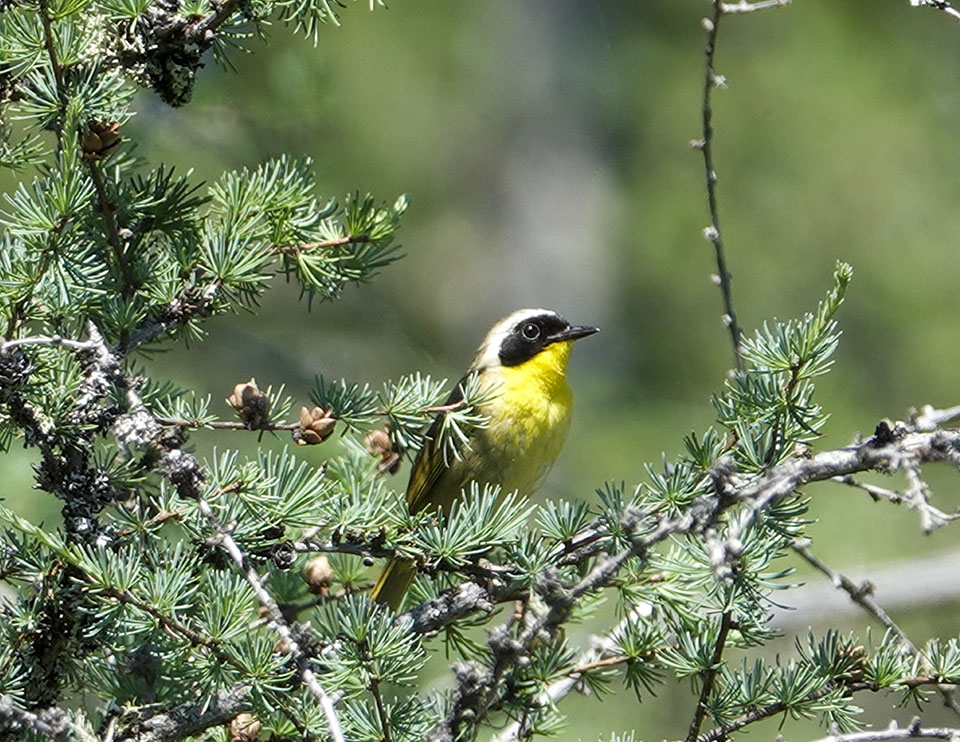
Common Yellowthroat: The Common Yellowthroat (Geothlypis trichas) is a small songbird with a yellow throat. The male is easiest to identify, with a distinctive black mask and a whitish band separating the mask from the crown and nape. The Common Yellowthroat’s loud “witchety-witchety-witchety” is heard throughout spring migration and on its breeding grounds from the time it arrives until it begins to molt in July or August.
The Common Yellowthroat is a short- to long-distant migrant that spends its winters south of us in Central America or the southern Gulf of Mexico. Our Yellowthroats begin arriving in small numbers in late April, with their numbers starting to wane in late September. By early October, most Common Yellowthroats will have left the Adirondack Park.
The Common Yellowthroat is one of the most widespread warblers in the North American continent, breeding from southeastern Alaska and Yukon, across most of Canada to Newfoundland in the east, and south along both coasts to southern Florida, California, the Gulf Coast and eastern Texas. In New York State, Common Yellowthroats are found during breeding season throughout the state.
Throughout their range, Common Yellowthroats breed in thick, tangled vegetation, but are most common in wet areas. In New York State, this warbler is primarily a bird of marshes, wet meadows, beaver ponds, and other moist shrubby areas. In the Adirondack Park, the Common Yellowthroat breeds in a variety of wetland ecological communities, including Shallow Emergent Marshes and Shrub Swamps.
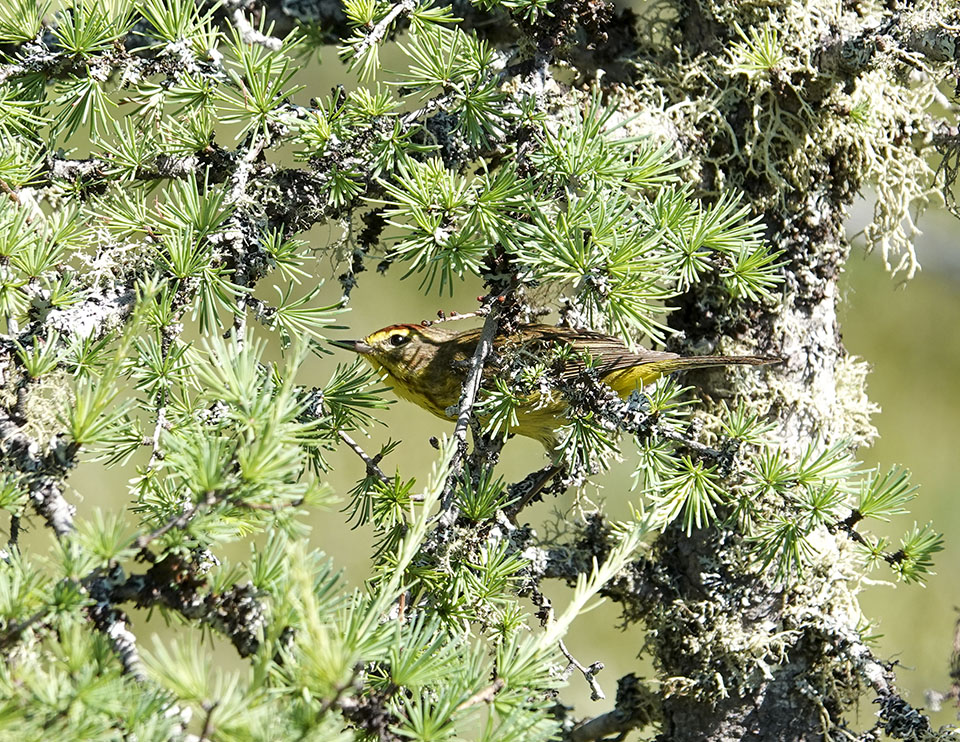
Palm Warbler: The Palm Warbler (Setophaga palmarum) is a another warbler that prefers wetlands. It is a rusty-capped, yellow and brown bird with bright yellow underparts and chestnut or reddish streaking on the breast. The Palm spends much of its time on the ground. It is known for its habit of bobbing its tail up and down, both on the ground and when perched. The Palm Warbler has a single song, which is reportedly used for both courtship and territorial defense. It is a buzzy, flat-toned trill, consisting of 4-16 buzzy syllables which are uttered slow enough to count but fast enough to sound like a continuous trill.
The Palm Warbler is a medium-distance migrant, spending its winters south of the Adirondack Park. It is a nocturnal migrant which migrates earlier in the spring and later in the fall than most other wood warblers. The Palm Warbler is one of the first warblers to arrive in the Adirondacks in the spring and one of the latest to leave our region in the fall.
Palm Warblers breed in boreal forests, with an estimated 98% breeding in Canada. The Palm Warbler's breeding range extends from the Northwest Territories to Newfoundland, southward to Minnesota, Wisconsin, Michigan, central Ontario, southern Quebec, and Maine. Palm Warblers breed in bogs and open boreal coniferous forests with scattered conifers, usually near water. Ecological communities in the Adirondacks which host Palm Warbler breeding pairs include Black Spruce-Tamarack Bog, Dwarf Shrub Bog, Spruce Flats, and Patterned Peatland.
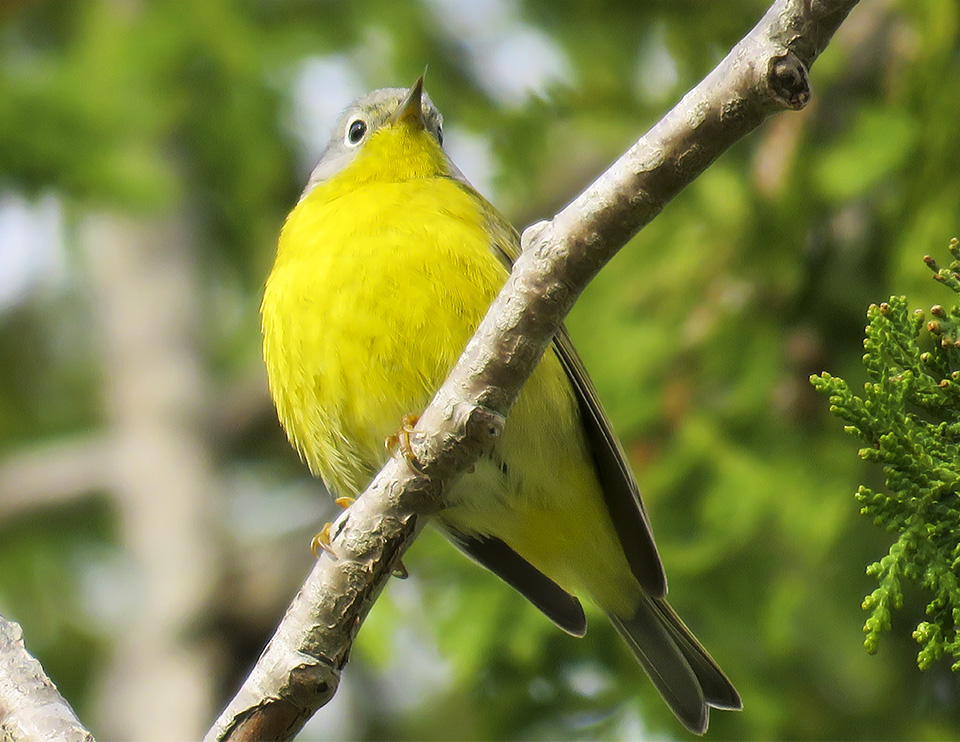
Nashville Warbler: Nashville Warblers (Leiothlypis ruficapilla) are striking yellow and gray birds with a bright, white eye ring. Male Nashville Warblers have bright yellow underparts and a blue-gray head. Female Nashville Warblers are somewhat paler and duller, with less contrast between the colors. Male Nashvilles sing a two-part song, each consisting of a series of similar syllables, best captured by the mnemonic: "pizza-pizza-pizza eat-eat-eat-eat."
The eastern population of Nashville Warblers breeds from central Saskatchewan to the maritime provinces in Canada and from northern Minnesota to New England, southward to Pennsylvania and the Appalachian Mountains to northeastern West Virginia in the US. In New York State, Nashville Warbler breeding populations concentrated in the Adirondack Mountains and Appalachian Plateau area.
The Nashville Warbler breeds in several different types of habitat. In New York State, the highest densities of Nashville Warblers are found at the edges of wetland areas, including bogs, marshes, and swamps. Ecological communities in New York State where Nashville Warblers are found include Black Spruce Tamarack Bog, Dwarf Shrub Bog, and Patterned Peatland, but this warbler may also breed in mountain conifer forests.
Warblers of Deciduous and Mixed-Wood Forests
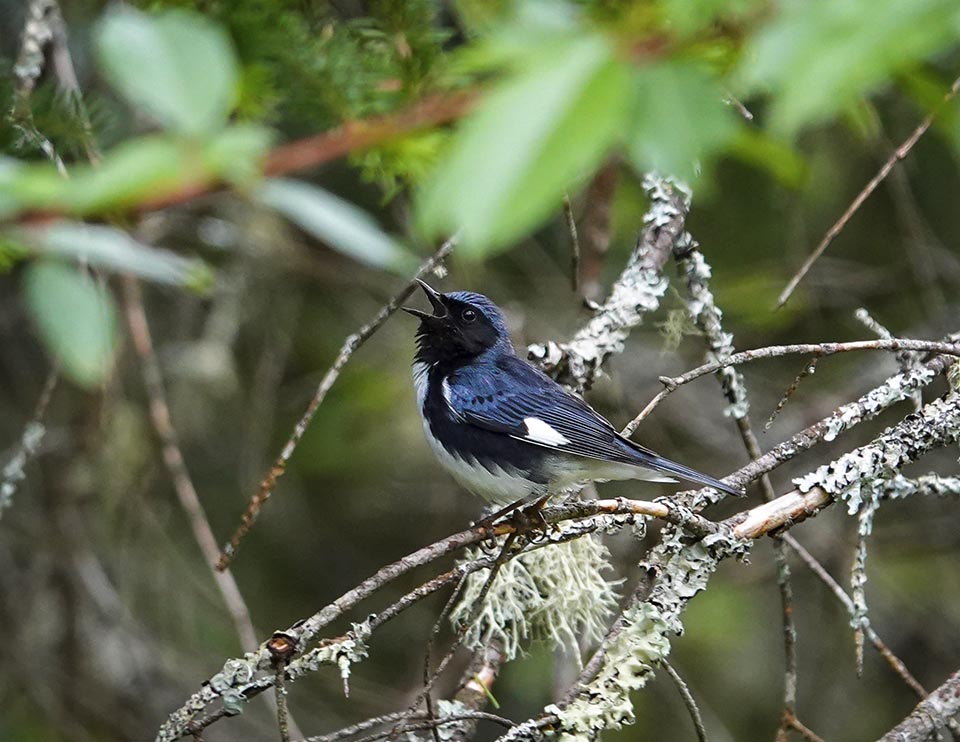
Black-throated Blue Warbler: Male Black-throated Blue Warblers (Setophaga caerulescens) are midnight blue birds with black and white markings and bright white chest and underparts. They sing a slow-paced, buzzy song often transcribed as "I am so lay-ZEEE." Adult female Black-throated Blue Warblers look nothing like the male; females are olive-brown or grayish olive overall, with lighter underparts. They are rarely heard singing.
Black-throated Blue Warblers breed in the northeastern US and southeastern Canada and spend the winter in the Caribbean. Black-throated Blue Warblers arrive in the Adirondack region starting in very late April. Most appear in the first week or two of May. By mid-October, most Black-throated Blue Warblers will have left the Adirondack region, with a few stragglers reported in the third week of October.
Black-throated Warblers breed in northern hardwood or mixed forest, with an apparent preference for hardwood forests. One of their habitat requirements is a thick understory of shrubs. In the Adirondacks, Black-throated Warblers are found in a variety of hardwood and mixed forest ecological communities, including Beech-Maple Mesic Forest, Hemlock-Northern Hardwood Forest, and Pine-Northern Hardwood Forest.
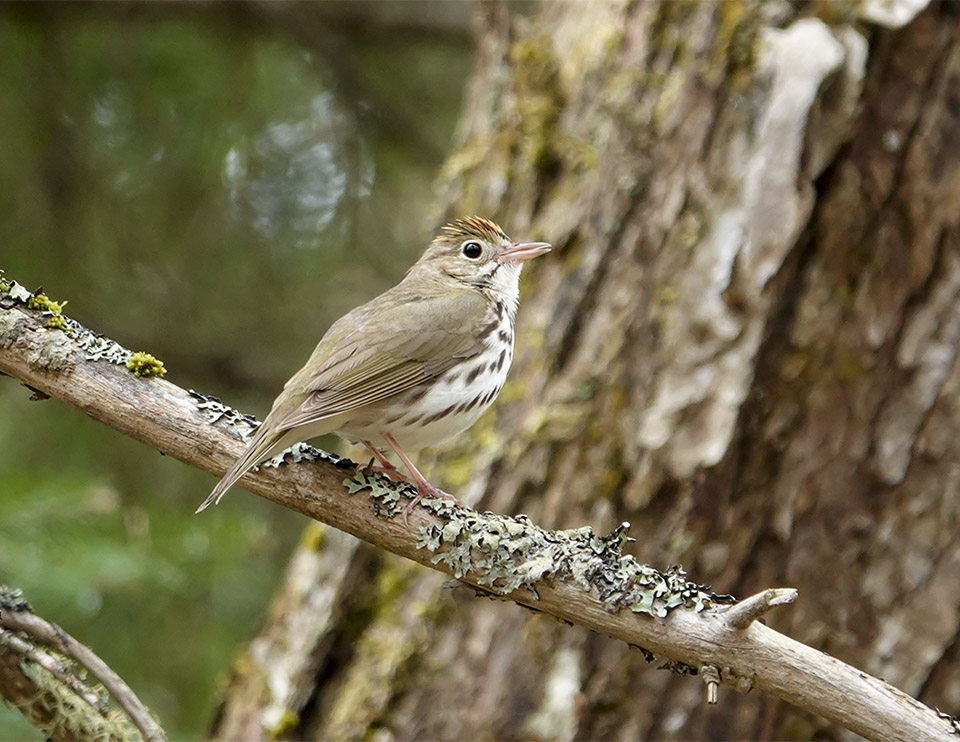
Ovenbird: The Ovenbird (Seiurus aurocapilla) is the largest of our warblers, with olive-brown upper parts, white underparts with bold, blackish-streaked spots, and a prominent white eye ring. It has an orange patch on the crown bordered by black. In contrast to most of our warblers, there is little difference between males and females; and immature birds look very much like adults.
Ovenbirds are more often heard than seen. Male Ovenbirds belt out a loud, repetitive series of about 8-12 two-parted notes from a mid-level perch: “tea-Cher, tea-Cher, tea-CHER, Tea-CHER, TEA-CHER.” The song generally rises in both volume and pitch.
The Ovenbird is a medium- to long distance-migrant that spends its winters in Mexico, Central America, Florida, and the Caribbean islands. It starts arriving in our region in early May. Nearly all of our Ovenbirds will have left for their wintering grounds by the end of the first week in October.
Ovenbirds breed in North America from eastern British Columbia and Alberta east to Newfoundland, and southward to Wyoming, Nebraska, Arkansas, and Georgia. This warbler is widely distributed across New York State. Ovenbirds breed in mature hardwood and mixed forests where there is an abundance of foraging substrate and dead leaves. This species requires large contiguous forest areas and is negatively affected by habitat fragmentation.
Warblers of Conifer and Mixed Woods Forests
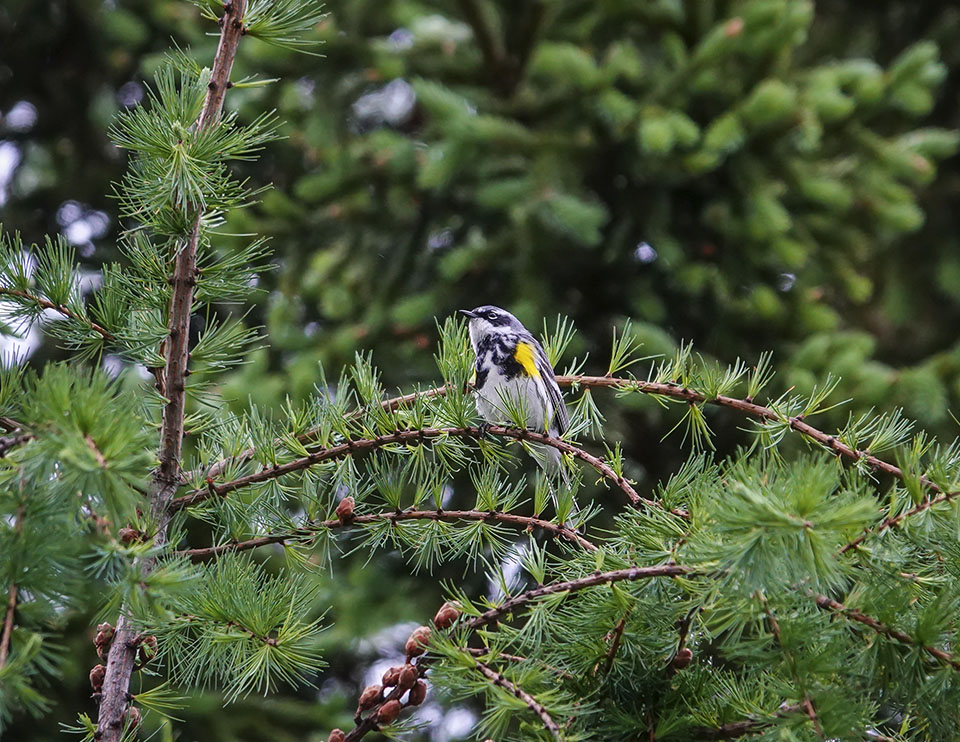
Yellow-rumped Warbler: The Yellow-rumped Warbler (Setophaga coronata) is a common yellow and black warbler, sometimes referred to by birders as the Butterbutt – a references to the distinctive bright yellow patch on its rump. Other field marks include yellow shoulder patches, light-colored eye arcs, wing bars, a large tail with large white spots and black edges, and a variably streaked chest, flanks, and back. Male Yellow-rumped Warblers on their breeding grounds sing a flat shivering trill, usually beginning about 30 minutes before sunrise.
The Yellow-rumped Warbler is one of the most abundant of all warblers. This species breeds from Alaska southeast across Canada and the northern US. In New York State, Yellow-rumped Warblers breed mainly in the Adirondacks, Tug Hill area, Catskill Peaks, and Appalachian Plateau.
Throughout their breeding range, Yellow-rumped Warblers breed mainly in conifer and mixed forests, preferring mature conifer forests dominated by spruce, pine, or cedar. In New York State, breeding Yellow-rumped Warblers are most often found in ecological communities dominated by conifers, particularly Mountain Spruce-Fir Forest, Alpine Krummholz, and alpine summits.
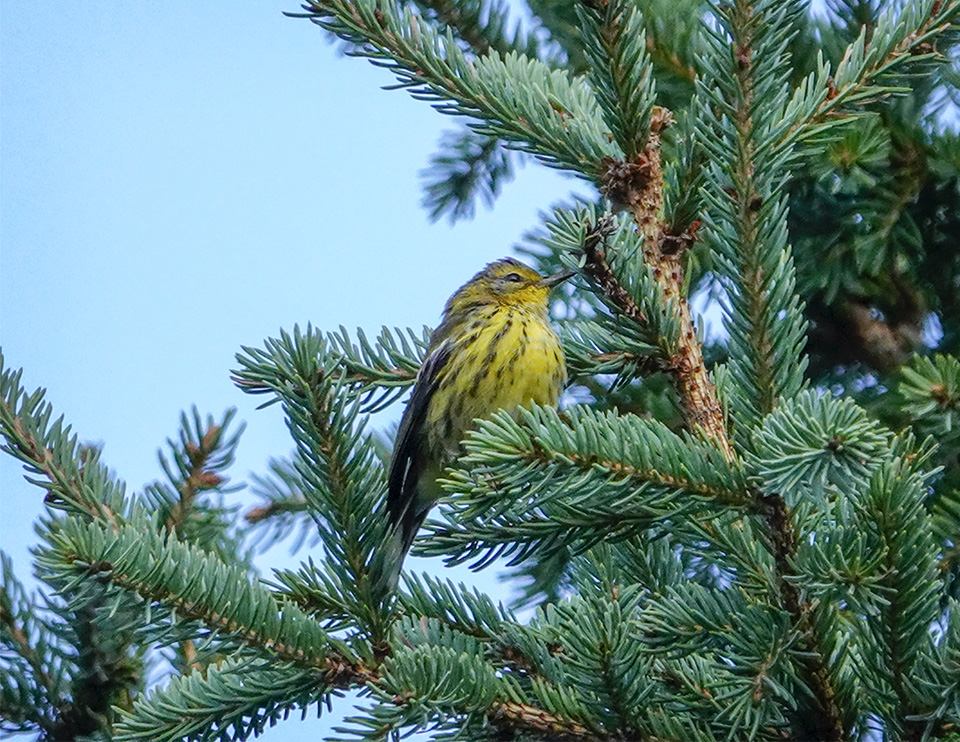
Cape May Warbler: Cape May Warblers (Setophaga tigrina) are small, rather chunk songbirds with a fine, slightly decurved bill. Cape May Warblers have streaked underparts which vary from off-white to bright yellow. Adult males in breeding plumage sport a bold head pattern with bright orange-chestnut ear patches, a bright yellow neck, and black crown. Females are less boldly colored than the male and lack the male's black cap and chestnut cheeks.
Cape May Warblers have two song types. One is a very high-pitched, thin "seet seet seet seet seet." This song consists of, on average, five notes on one pitch of even cadence and volume, with about three to four notes per second. The Cape May Warbler's alternate song consists of several two-syllable notes. This song is lower in pitch and is given at relatively longer intervals.
Cape May Warblers breed in Canada and the northern United States, with an estimated 98% of Cape May Warblers breeding in Canada. In the US, Cape Mays breed in the northern Great Lakes Region, as well as northern New England and the Adirondack Mountains.
Cape May Warblers breed in boreal forests, usually in medium- to old-aged coniferous habitats with spruce (particularly Black Spruce) and Balsam Fir. This species appears to favor spruce stands with tall, well-developed crowns, as well as areas hit by spruce budworm outbreaks.
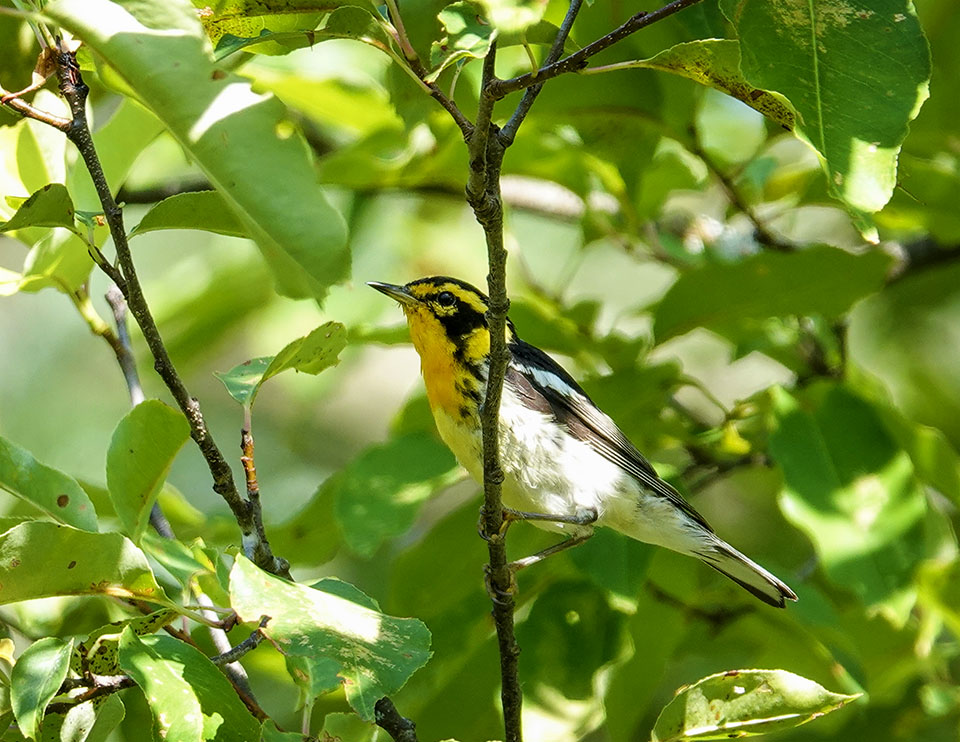
Blackburnian Warbler: Blackburnian Warblers (Setophaga fusca) are small songbirds with dark, triangular cheek patches. Male Blackburnian Warblers in breeding plumage have a brilliant orange throat and face with black triangular ear patches. Adult female Blackburnian Warblers in breeding plumage are a paler and yellower version of their male counterparts, with a charcoal or gray triangular cheek patch.
In our area, male Blackburnian Warblers have essentially two songs, both with two, distinct parts. One begins with a short series of high notes (usually three notes), followed by a lower-pitched series of four or five notes. The other begins low and ends high; the first part of the song is a series rapid two-part notes (usually five or six). This is followed by one or two very high notes.
The breeding range of Blackburnian Warblers is in northeastern North America. In New York State, Blackburnian Warblers breed mainly in the Adirondack Mountains, the Tug Hill Plateau, and Appalachian Plateau (particularly the eastern portions including the Catskills).
The Blackburnian Warbler is characteristically associated with mature conifer forests (such as balsam flats and mountain spruce-fir forests) and mixed forests dominated by conifers, such as hemlock-northern hardwood forests and spruce flats. This species shows a marked preference for mature forest.
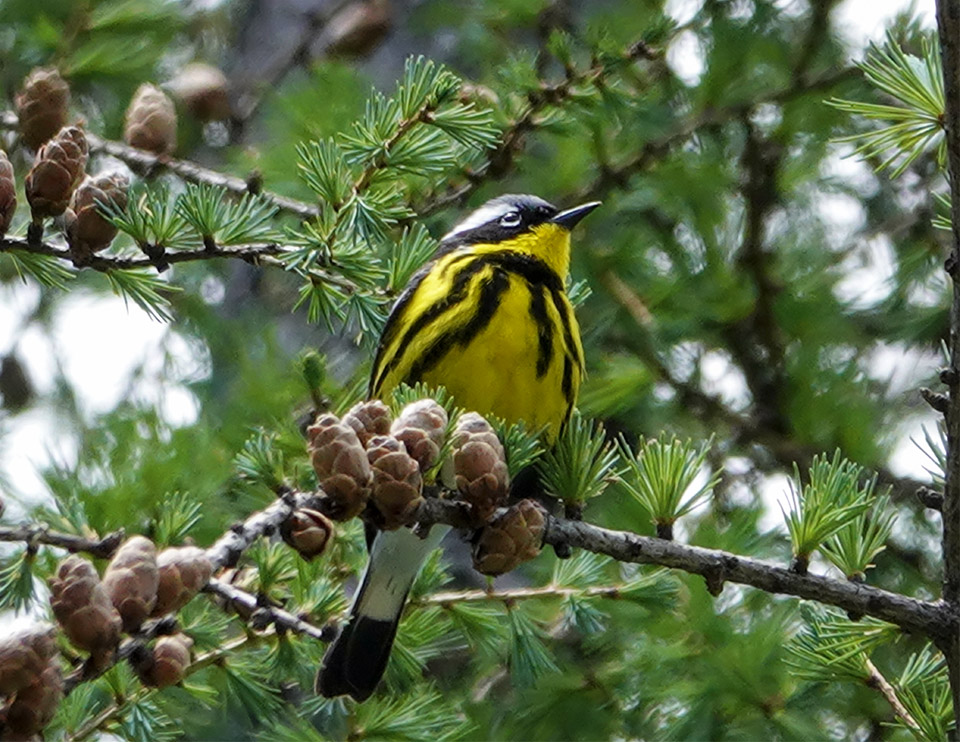
Magnolia Warbler: Magnolia Warblers (Setophaga magnolia) are black and yellow songbirds with a unique tail pattern. They have a black and white tail which, from the underside, looks like the tip was dipped in black ink. Male Magnolia Warblers are bright yellow and black, with a bold black necklace, a prominent black mask, and a large white wing patch. Adult female Magnolia Warblers in breeding plumage are paler than their male counterparts, with a fainter face pattern and less black on the back.
Male Magnolia Warblers have several different songs. The songs are about a second or two long and rather musical. Many birders find the following mnemonics useful as a memory aid: "wheet-wheet'eo" or "weeta-weeta-weetsee."
Magnolia Warblers winter south of the continental United States and breed in Canada and the northeastern US. In New York State, Magnolia Warblers breed mainly in the Adirondacks, Tug Hill area, and Appalachian Plateau.
The Magnolia Warbler is characteristically associated with dense stands of young conifers, especially spruce. Throughout its range, this species breeds in both conifer and mixed forests. It favors small, close-growing young conifers (such as Red Spruce and Balsam Fir) in either pure stands or mixed with hardwoods. Magnolia Warblers are most abundant in young, second-growth spruces, where they reportedly are the dominant species.
Warblers of Successional and Young Forest Habitats
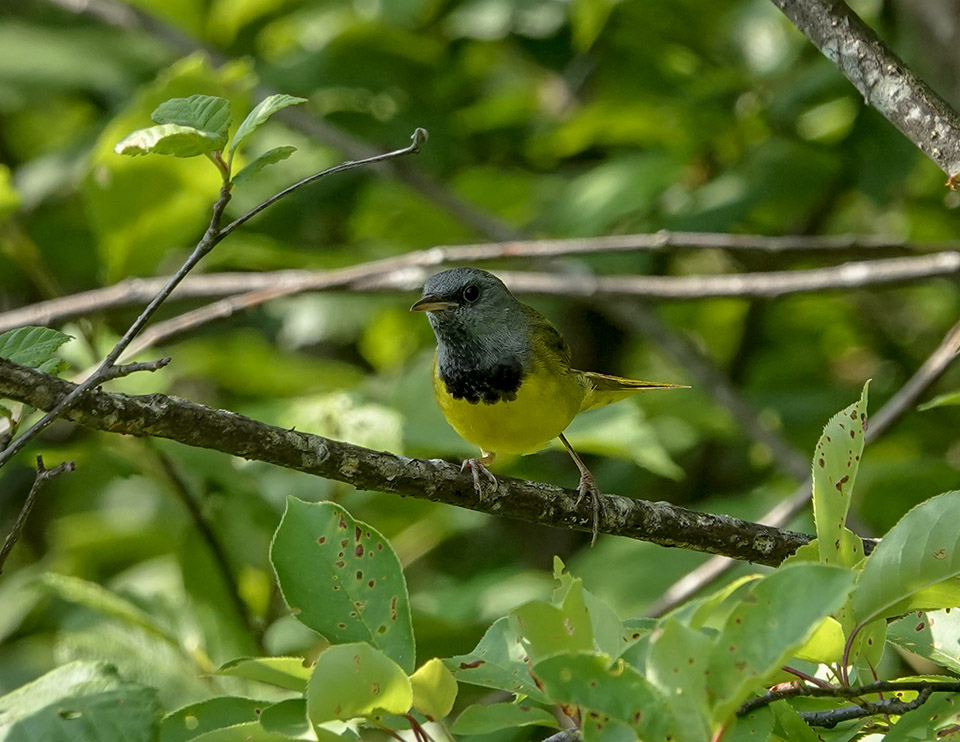
Mourning Warbler: The Mourning Warbler (Geothlypis philadelphia) is a chunky warbler with a gray hood, olive-green upperparts , and solid yellow underparts. The adult male Mourning Warbler in spring has a dark blue-gray head and throat with a black-mottled patch on his upper breast. Adult females in spring are similar to their male counterparts, but are somewhat paler and lack the black feathering on the chest.
The Mourning Warbler's primary song is a series of two-syllable phrases, usually with two parts. The second pair of notes usually drops slightly in pitch. Most sources render the song as: "chirry, chirry, chirry, chorry, chorry." Only the male Mourning Warbler sings, presumably as an advertisement of its territorial and sexual status. Mourning Warblers are most commonly heard singing during the early part of the breeding cycle, from late May to mid-July.
The Mourning Warbler is a long-distance migrant that spends its winters in Central and South America. It is one of the last warblers to head northward toward its breeding grounds in the spring and one of the earliest to head south again in the fall. Few Mourning Warblers show up in our region until the latter half of May and most will have departed our region by very late August or the first week in September.
The Mourning Warbler breeds from Alberta and extreme eastern British Columbia east to Newfoundland. In the US, its breeding range includes parts of New England, New York, and the Great Lakes region. Mourning Warblers breed throughout much of New York State, with concentrations in the northern and southwestern parts of the state.
Mourning Warblers are an early successional species that nest in second-growth forests. This warbler colonizes clearings with dense second growth caused by either human or natural disturbances, including logging, road building, fire, and winter ice storms. Mourning Warblers also breed in abandoned cultivated fields or forest edges and are often found in the brushy understory in dense tangles of bushes and young saplings.
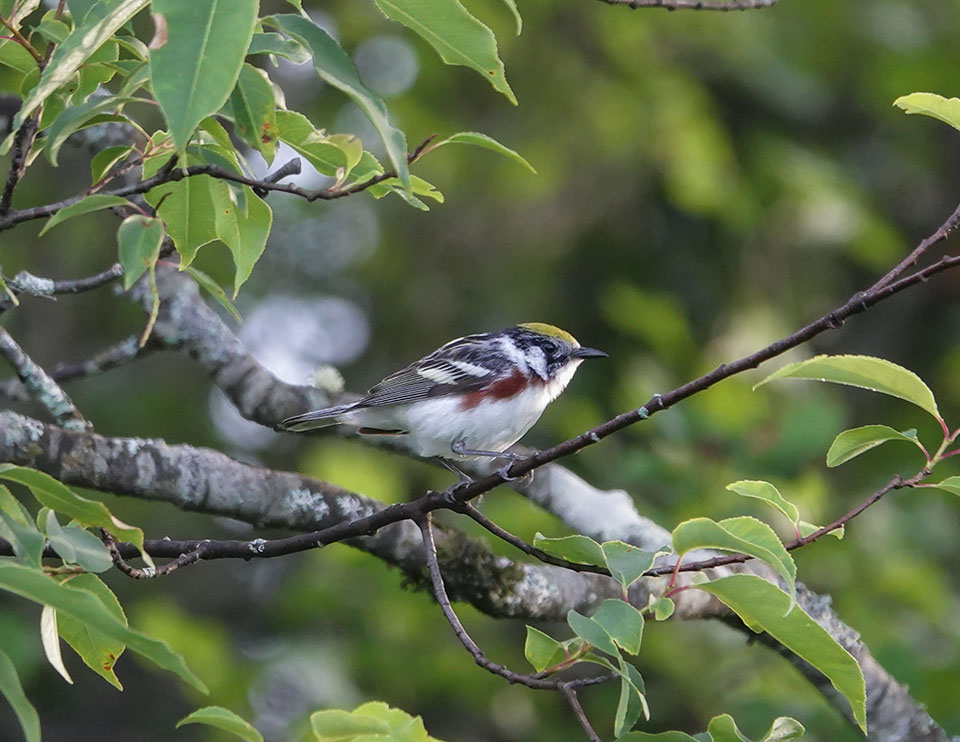
Chestnut-sided Warbler: The Chestnut-sided Warbler (Setophaga pensylvanica) is a greenish-yellow, black, and white warbler with a chestnut streak on its sides. Breeding males have a bright yellow crown, yellow and black stripes on the back, a black and white face with white cheeks and a black mask, and extensive chestnut coloration. Breeding females have duller coloration than males, with less extensive chestnut streaking.
Male Chestnut-sided Warblers sing an accented-ending song, with louder concluding notes. Many birders find it useful to remember the song by linking it with the mnemonic "see-see-see-Miss-BeeCHER." Nearly all singing is done within the male's territory, usually from elevated perches in trees.
Chestnut-sided Warblers are long-distance migrants that winter in Central America. In the Adirondack Park, Chestnut-sided Warblers appear to arrive starting the first week in May. Chestnut-sided Warblers apparently begin leaving breeding grounds in the Adirondack region in August. By the first week in October, most Chestnut-sided Warblers appear to have left the Adirondack region.
Chestnut-sided Warblers are one of the more common warblers. They breed throughout New York State. Like the Mourning Warbler, the Chestnut-sided Warbler is an early successional species, nesting in second-growth deciduous forest. These warblers are found in brushy thickets, bushy pastures, forest openings, the edges of forests, and neglected roadsides.
Habitat Generalists
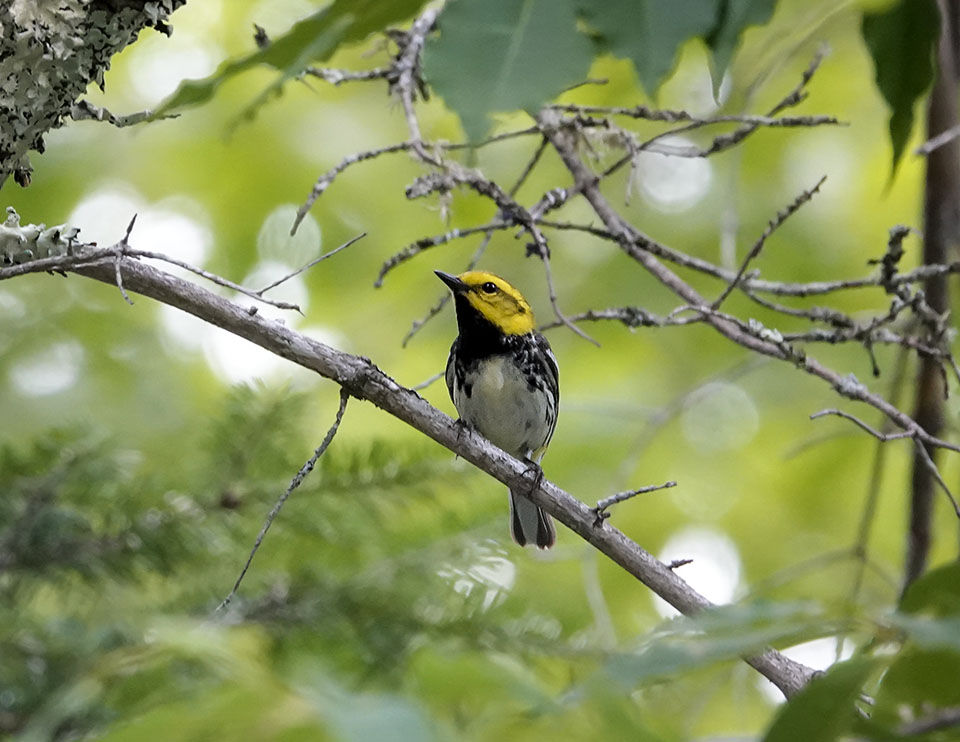
Black-throated Green Warbler: Black-throated Green Warblers (Setophaga virens) are medium-sized warblers with green upperparts, a yellow face with olive markings, white wing bars, and pale underparts. The black throat from which this species derives its name is most prominent on breeding males, which sport a striking black chin, throat, and upper chests and a bright white belly streaked with black on the sides.
Male Black-throated Green Warblers sing two distinct songs. The unaccented song is a buzzy zee zee zoo zoo zee. It is sung during territorial interactions and directed at other males. The accented song, which is sung to attract and communicate with female birds, is a series of buzzy notes, with the first three or four on the same pitch, the next lower, and the last higher.
The Black-throated Green Warbler is a long-distance migrant, wintering in the southern US, Central America, and northern South America and returning to the Adirondacks in late April and early May to breed. Most of our Black-throated Green Warblers leave in very late September and early October. Nearly all will have left by mid- to late October.
The Black-throated Green Warbler breeds in the northeastern US across southern Canada to north eastern British Columbia, and southward through the Appalachian Mountains to northern Alabama. The Black-throated Green Warbler uses a variety of habitats throughout its range. In much of the Adirondack region, breeding pairs are most commonly found in coniferous forests or mixed woods.
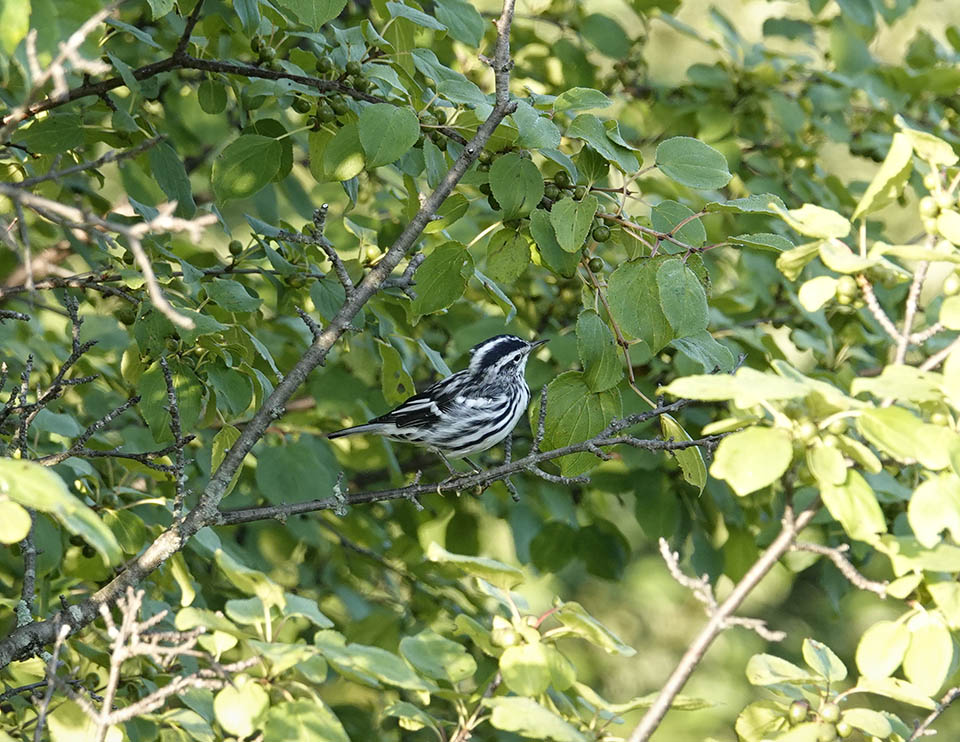
Black-and-white Warbler: The Black-and-white Warbler (Mniotilta varia), as the name implies, sports a black and white striped crown and back. Its song is a lengthy series of thin, squeaky high-pitched notes, sometimes described as the sound of a squeaky wheel. This warbler is usually seen creeping along branches and trucks, often upside down, like a nuthatch.
The Black-and-white Warbler (like the Yellow-rumped Warbler, Palm Warbler, and Pine Warbler) is an early-arriving migrant, with a few birds showing up in late April. The first two New York breeding bird atlases found this warbler to be a common and widespread breeder through much of the eastern half of the state. Preliminary sightings from the third New York Breeding Bird Atlas show most confirmed breeding sites concentrated in the Adirondacks, Catskills, and eastern parts of the state.
The Black-and-white Warbler is a habitat generalist. It breeds in a variety of deciduous and mixed woodlands, in both mature and second-growth forests. The understory and ground cover may vary from dense to open, but generally with some tangled vegetation providing concealment for its nests (which are usually placed on the ground). In New York State, the Black-and-white Warbler occupies a variety of breeding habitats, including alpine krummholz, early to mid-successional forest, mature and second growth deciduous and mixed forests, and forested wetlands. It apparently is most abundant in early successional forest conditions.
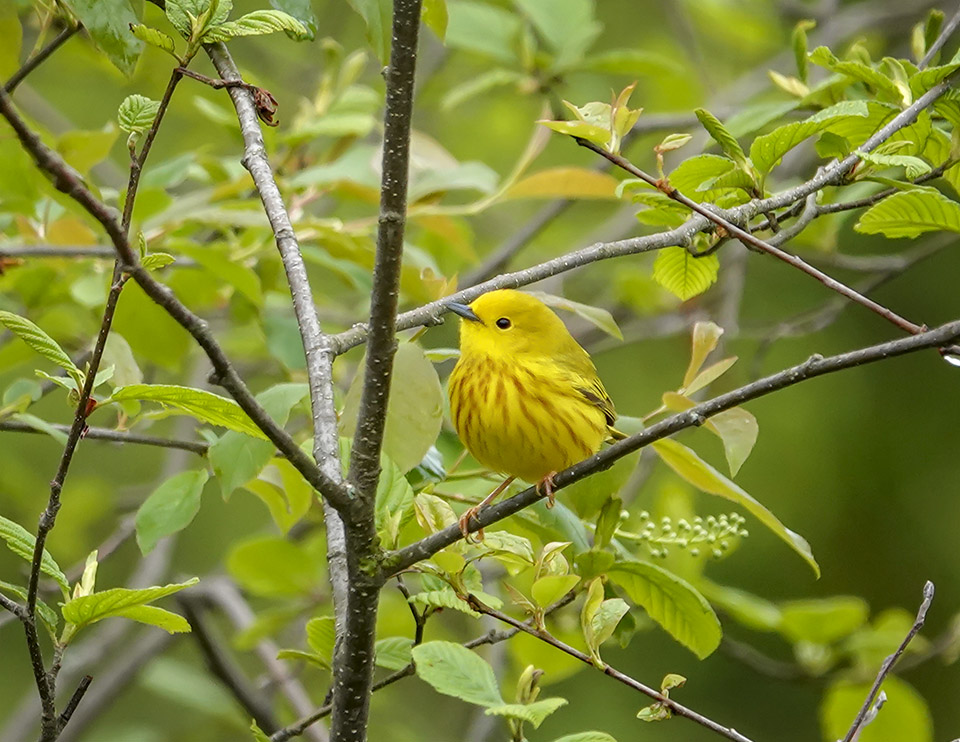
Yellow Warbler: The Yellow Warbler (Setophaga petechia) is one of the most numerous warblers in North America. Yellow Warblers are striking yellow birds, with variable amounts of chestnut streaking on the breast. The male Yellow Warbler song is a series of whistles that sounds like “Sweet, sweet sweet. I’m so sweet.” It is somewhat similar to the song of the Chestnut Warbler.
The Yellow Warbler is a long-distance migrant that spends its winter in Central America and northern South America. It begins arriving in our area in late April; most will have left by the end of September.
In New York State, the Yellow Warbler is more abundant outside the Adirondack Mountains than within the Park. Preliminary results from New York Breeding Bird Atlas III show confirmed breeding sites throughout the state, but few in the Adirondacks or Catskills. Cemetery Road Wetlands is one of the relatively few confirmed breeding sites for the Yellow Warbler within the Adirondacks. Although the Yellow Warbler breeds in a wide variety of habitats throughout its range, it is most commonly found in our region in wet, deciduous thickets.
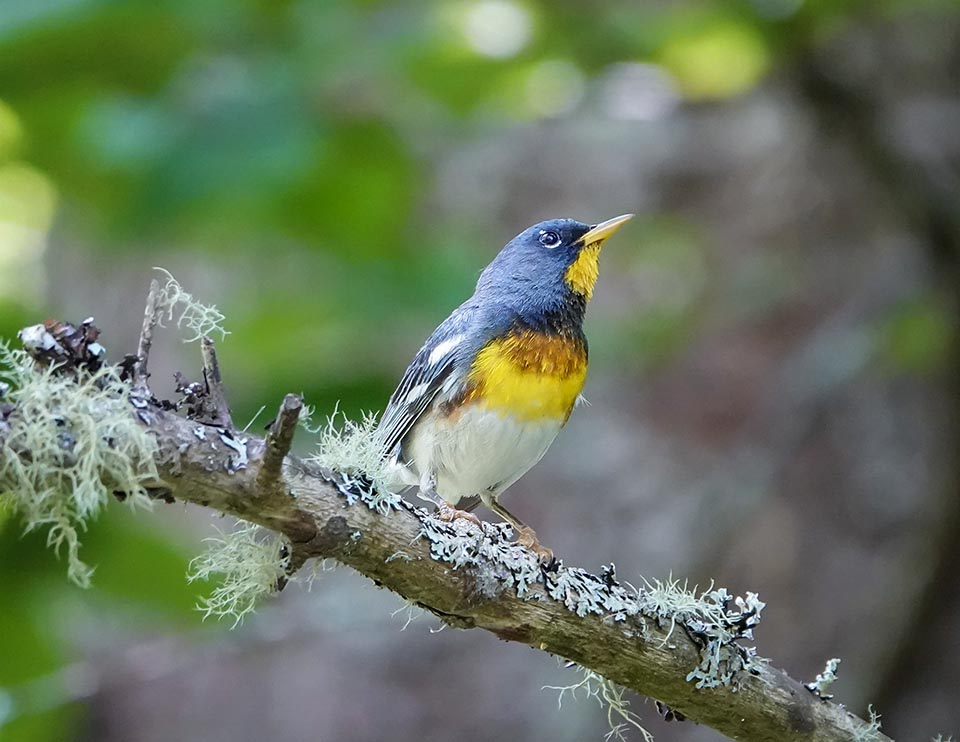
Northern Parula: The Northern Parula (Setophaga americana) is one of the smallest of the Wood Warblers. Adults have a blue-gray back with a yellowish green patch. The throat is yellow; and the belly is white with no streaking. In spring, male Northern Parulas have a chestnut-orange breast band separating the bright yellow of the throat from the bright yellow of the breast. The breast band is absent or a very light chestnut in females.
Northern Parulas usually sing in the mid- and upper canopy, hopping and jumping from branch to branch and often foraging while singing. Their main song is a buzzy trill, ascending in pitch, dropping abruptly at the end, rather like a zipper being pulled up quickly.
Northern Parulas are long-distance migrants that winter in Mexico, Central American, and the Caribbean. Northern Parulas are rarely seen in the Adirondack region before early May. Most appear to arrive in mid- to late May. Northern Parulas begin to leave their breeding grounds here in late August.
Northern Parulas breed in eastern North America, from southeastern Manitoba and Nova Scotia south to the Gulf Coast and northern Florida, with a gap between the northern and southern parts of their breeding territory. In New York State breeding pairs of Northern Parulas are concentrated in the Adirondack Mountains, with another cluster in the Tug Hill area and a few individual sites scattered outside the Blue Line, including the Finger Lakes area and Long Island.
The Northern Parula's breeding habitat varies. They breed in deciduous, coniferous, or mixed woodlands in the northern part of their range, preferring moist woods and swamps where Beard Lichen (Usnea lichen) is found. In the southern part of their range, Northern Parulas apparently favor deciduous woodland where Spanish Moss (Tillandsia) is abundant. In New York State, this warbler nests in open hardwood or conifer forests and swamps, with nesting locations generally limited to places with Usnea lichen.
References
Cornell Lab of Ornithology, Ithaca, New York. All About Birds. American Redstart, Bay-breasted Warbler, Black-and-white Warbler, Blackburnian Warbler, Blackpoll Warbler, Black-throated Blue Warbler, Black-throated Green Warbler, Blue-winged Warbler, Canada Warbler, Cape May Warbler, Cerulean Warbler, Chestnut-sided Warbler, Common Yellowthroat, Connecticut Warbler, Golden-winged Warbler, Hooded Warbler, Kentucky Warbler, Louisiana Waterthrush, Magnolia Warbler, Mourning Warbler, Nashville Warbler, Northern Parula, Northern Waterthrush, Orange-crowned Warbler, Ovenbird, Palm Warbler, Pine Warbler, Prairie Warbler, Prothonotary Warbler, Tennessee Warbler, Wilson's Warbler, Worm-eating Warbler, Yellow Warbler, Yellow-rumped Warbler. Retrieved 20 March 2021.
Cornell Laboratory of Ornithology, Ithaca, NY. Birds of the World. American Redstart, Bay-breasted Warbler, Black-and-white Warbler, Blackburnian Warbler, Blackpoll Warbler, Black-throated Blue Warbler, Black-throated Green Warbler, Blue-winged Warbler, Canada Warbler, Cape May Warbler, Cerulean Warbler, Chestnut-sided Warbler, Common Yellowthroat, Connecticut Warbler, Golden-winged Warbler, Hooded Warbler, Kentucky Warbler, Louisiana Waterthrush, Magnolia Warbler, Mourning Warbler, Nashville Warbler, Northern Parula, Northern Waterthrush, Orange-crowned Warbler, Ovenbird, Palm Warbler, Pine Warbler, Prairie Warbler, Prothonotary Warbler, Tennessee Warbler, Wilson's Warbler, Worm-eating Warbler, Yellow Warbler, Yellow-rumped Warbler. (S. M. Billerman, B. K. Keeney, P. G. Rodewald, and T. S. Schulenberg, Editors). Subscription Website. Retrieved 20 March 2021.
Cornell Lab of Ornithology, Ithaca, New York. eBird. An Online Database of Bird Distribution and Abundance. Bird Observations (Warren, Hamilton, Essex, Herkimer, Clinton, Franklin). Retrieved 7 April 2021.
Cornell Lab of Ornithology, Ithaca, New York. eBird. An Online Database of Bird Distribution and Abundance. Bird Observations (Hamilton). Retrieved 7 April 2021.
Cornell Lab of Ornithology, Ithaca, New York. eBird. An Online Database of Bird Distribution and Abundance. Bird Observations (Essex). Retrieved 7 April 2021.
Cornell Lab of Ornithology, Ithaca, New York. eBird. An Online Database of Bird Distribution and Abundance. Bird Observations (Clinton, Essex, Franklin, Fulton, Hamilton, Herkimer, Lewis, Oneida, Saratoga, St. Lawrence, Warren, Washington counties). Retrieved 7 April 2021.
New York Breeding Bird Atlas III. Species Maps. Retrieved 20 March 2021.
Kevin J. McGowan and Kimberley Corwin (Eds). The Second Atlas of Breeding Birds in New York State (Cornell University Press, 2008), pp. 466-535, 635 -641.
Robert F. Andrle and Janet R. Carroll (Eds.) The Atlas of Breeding Birds in New York State (Cornell University Press, 1988).
New York State. Department of Environmental Conservation. New York Natural Heritage Program. Ecological Communities of New York State. Second Edition (March 2014. Retrieved 8 April 2021.
Douglass H. Morse. American Warblers: An Ecological and Behavioral Perspective (Harvard University Press,1989). Retrieved 7 April 2021.
Kimball L. Garrett and John B. Dunning, Jr., "Wood-Warblers ," in Christ Elphick, John B. Dunning, Jr., and David Allen Sibley (eds.), The Sibley Guide to Bird Life & Behavior (Alfred A. Knopf, 2001), pp. 492-509.
Jon L. Dunn and Kimball L. Garrett. A Field Guide to Warblers of North America (Houghton Mifflin Company, 1997), pp. 5-30. Retrieved 7 April 2021.
Tom Stephenson and Scott Whittle. The Warbler Guide (Princeton University Press, 2013.
Alexander Skutch, "An Introduction to the Warbler Family," in Ludlow Griscom, Alexander Sprunt, Jr. et al., Eds. The Warblers of North America (The Devin-Adair Company, 1957), pp. 3-5. Retrieved 16 January 2020.
Frank M. Chapman. The Warblers of North America. Third Edition (D. Appleton & Company, 1907). Retrieved 4 April 2021.
Chris G. Earley. Warblers of the Great Lakes Region & Eastern North America (Firefly Books, 2003). Retrieved 4 April 2021.
Jon Curson, David Quinn and David Beadle. Warblers of the Americas. An Identification Guide (Houghton Mifflin Company, 1994). Retrieved 20 March 2021.
Arthur Bent. Life Histories of North American Wood Warblers. Part One and Part Two (Smithsonian Institution. United States National Museum. Bulletin 203, 1953). Kindle Book. Retrieved 13 November 2018.
George K. Peck and Ross D. James. Breeding Birds of Ontario: Nidiology and Distribution. Volume 2: Passerines (Royal Ontario Museum, 1987). Retrieved 20 March 2021.
